Lately, I’ve been experimenting with a couple of scopes from Bushnell; one from their Elite Tactical line, and the other one is a lower powered rimfire optic. An interesting feature on both of these scopes is the parallax compensation adjustment.
I don’t usually prioritize this feature as a must-have in the scopes that I buy, but I can understand why some people like it. In discussing the issue with other shooters, I’ve found that there are some common misunderstandings not just about parallax adjustment, but about scope parallax in general. I think that’s at least partly due to the fact that the concept of parallax is often explained in an overly-technical way that many people either find confusing or boring.
Fortunately, you don’t actually have to wrap your head around all of the technical details of parallax in order to have a basic understanding that’s sufficient enough for most shooters to make adjustments for it. Compare it to something like bullet drop — I don’t have to know how to calculate the constant of gravity versus the bullet’s velocity and mass and the curvature of the earth in order to know that when I shoot my .308 at 200 yards with my favorite factory ammo, I have to hold about 3.5 inches high.
So in today’s video, I’ve taken my best shot at explaining what rifle scope parallax is for the average shooter, as opposed to someone who wants to make a career in optics manufacturing.
What is Rifle Scope Parallax? Watch the Video:
If you’re the average hunter or if you’re just shooting at the range for fun, then you probably won’t have to worry about parallax too much. But if you’re after extreme accuracy with high magnification scopes, or you’re shooting at super close ranges like a lot of competitive air gun shooters, then it’s something you should know about and consider when you’re buying a scope.

